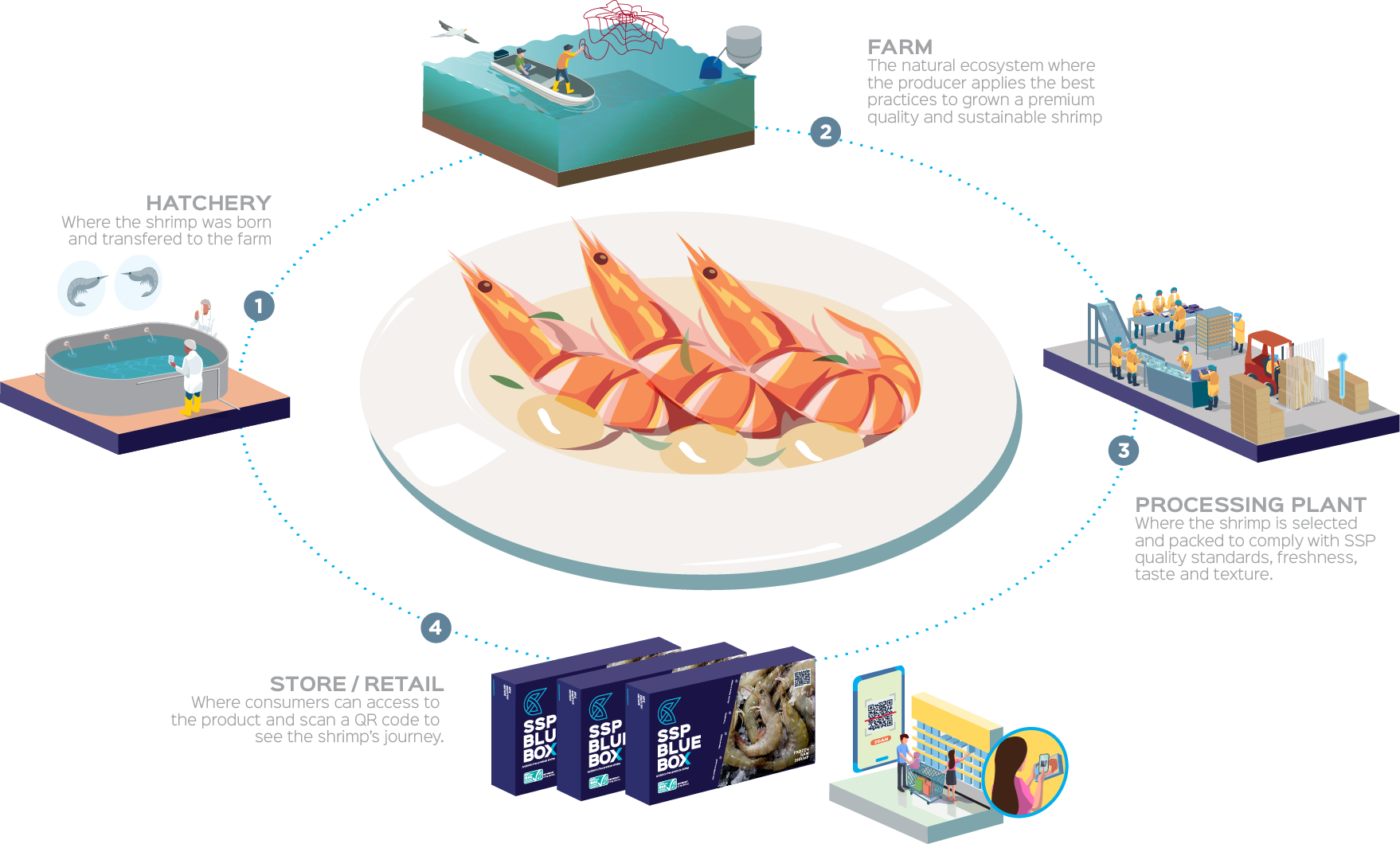The Taste of Information: Trust in Every Bite
Behind every shrimp, there's a story, and traceability stands as a vital tool to ensure that it's of the highest quality.
Pamela Nath and Sally Tabares
October 6th, 2023
The absence of information and awareness regarding the production of food frequently results in consumers unknowingly ingesting harmful substances to their health. Often, they fail to consider the potential societal and environmental repercussions of production practices. In this context, traceability assumes a crucial role, as emphasized by Dr. Leonardo Maridueña, an expert in Environment, Aquaculture, and Fisheries.
“With traceability, one knows exactly how the animal was treated, what it was fed, and what was administered to it. People can consume it with peace of mind because they know it won’t harm them,” explains the doctor, who also serves as the Director of Environment at the National Chamber of Aquaculture (CNA).
Traceability is the process by which every component involved in each stage of a production is documented. It is the ability to track the historical record, application, and location of a product, including the origin of its materials, parts, and process history, as defined by the International Organization for Standardization (ISO).
An effective traceability system provides assurances that the product reaching the end consumer complies with all regulations, not only in terms of safety – the quality of a food or product not causing harm or risk to consumer health – but also in terms of environmental, social, business ethics, fair trade standards, among other factors. This is outlined by Yahira Piedrahita, the Executive Director of CNA and a board member of the World Aquaculture Society.
“Traceability builds trust with consumers and can serve as a marketing strategy against competitors who do not have the same levels of quality and control,” describes Piedrahita, who recently published a book on end-to-end traceability in fishing and aquaculture value chains with the Food and Agriculture Organization of the United Nations (FAO).
Year after year, the global demand for transparency and social responsibility in the food industry continues to grow. Consumers are increasingly interested in the reliability and authenticity of the industry, seeking accurate and easy-to-understand information about the responsible origin of food, its ingredients, carbon footprint, and food safety, as stated in the FAO’s study “Thinking About the Future of Food Safety: A Foresight Report.”
“Traceability has become both a legal requirement and a business necessity. It records the information that one considers most important for consumers or clients,” reveals Maridueña.
The doctor informs that this selection of data depends on the risk analysis conducted on the shrimp production system and the public opinion generated through the media.
Consumption habits are constantly evolving in line with consumer priorities. The FAO indicates that climate change, the concern for healthier and more sustainable diets, and the reduction of environmental impact in food production are having a significant effect on consumption patterns.
Moreover, the 2023 Edelman Trust Barometer report highlights people’s aspiration for companies to tackle challenges like climate change.
“In response to these concerns, information and labels are being added to the product’s packaging,” outlines Maridueña.
The European Commission conducted the Special Eurobarometer 515 report, which states that European consumers consider the capture or production date, environmental information, and the country of origin of the product to be the most important traceability data that should be on labels of fish and aquaculture products.
Similarly, the latest study by the International Food Information Council (IFIC), titled “Understanding ‘Healthy’ and the Impact of Nutrition Labeling on Food Decisions,” found that nearly half of the surveyed consumers believe that front-of-package labeling significantly influences their food choices, while a similar proportion finds this information helpful in determining the healthiness of products.
In the legal sphere, various international organizations, including the World Trade Organization (WTO), the World Organisation for Animal Health (WOAH), the Food and Drug Administration (FDA), the European Union, and the FAO, among others, have all recognized traceability as a fundamental requirement for accessing food markets in foreign countries. Furthermore, international certifications like Global G.A.P., Aquaculture Certification Council (ACC), and ISO have also incorporated traceability as a cornerstone of their standards.
These events have underlined the paramount significance of traceability within the food industry. Given that the shrimp aquaculture sector is one of the fastest-growing on a global scale, it becomes imperative to address a critical question: How can we guarantee traceability throughout the shrimp value chain and secure consumer trust in this product?
The most important aspect is to comprehend the responsibility held by each party involved in traceability. “There are two groups of actors: the official entities, which are the state institutions in charge, and the actors within the reproductive chain,” says Piedrahita.
She explains that at each stage of the shrimp breeding and processing, it is necessary to identify the critical control points and key elements that must be documented.
“Those involved in the value chain are responsible for monitoring and recording this data, while government institutions oversee the compliance with established controls and the accurate documentation of information. This guarantees the functionality of the traceability system and ensures that the end consumer has access to all necessary information in case of any issues or market audits,” she clarifies.
Within the production chain, traceability starts in the laboratories and hatcheries. The first actor involved is the larval producer, who bears responsibility from reproduction through to the larva’s sale.
The larval producer’s mission is to document the organism’s development during this stage. Factors such as the selection of breeders, their diet, any adverse events that may have occurred, how they were managed, and to whom the produced larvae were sold must be taken into account.
“In traceability, it’s not only about what happens during each stage but also what occurs once that stage is completed. Having all the details well-documented is crucial. For instance, in the case of shrimp larvae, producers know who they are selling to and which pond these animals will go to. They also keep track of the quantity of larvae they sell,” Maridueña explains.

The subsequent phase in traceability involves shrimp farming at the aquaculture farm. Here, the production manager shoulders the responsibility of meticulously documenting both biotic and abiotic processes. This includes aspects such as the application of probiotics (biotic) and critical factors like temperature, salinity, dissolved oxygen, and more (abiotic).
“During this cultivation stage, it’s essential to specify in which pond the shrimp are located, what kind of feed they were given, any products used on the animals, whether any medication was necessary, which medication was used, at what dosage, and for how many days,” adds Piedrahita.

The next significant step in traceability takes place at the processing plant. Its primary function is to assess the quality of the received shrimp. To achieve this, they employ a straightforward method called organoleptic assessment, which involves examining the shrimp’s sensory characteristics, including taste, texture, and color.
Regarding product quality, particularly in terms of presentation and size, it falls under the purview of the quality manager to decide which portions are suitable for peeling and deveining and which should be marketed as whole shrimp. Maridueña emphasizes that a crucial aspect of traceability during this stage is ensuring compliance with the regulations of the destination country regarding the maximum allowable limit of metabisulfite. This antioxidant is employed to remove oxygen from the shrimp after harvesting, preventing organoleptic changes and preserving the product’s appearance. It’s important to note that this additive must be accurately disclosed because exceeding the permissible limit can have adverse effects on consumer health.
Another central aspect at this stage is to ensure that once shrimp have been packaged, they are kept in freezing chambers at a minimum temperature of -18 degrees Celsius, with -20 degrees Celsius being optimal. The doctor points out that this information should be clearly indicated on the shrimp packaging.
The next phase in the traceability of the supply chain is related to transportation. “Its primary function is to establish the timelines from the moment the merchandise is shipped until it reaches the destination port, where it will be collected by the buyer or retailer,” states Maridueña.
At this stage, the entry date and the departure date of the product are recorded. The biologist emphasizes the importance of ensuring that the prescribed timeframe set by the packaging is not exceeded.
The final step in traceability falls on the seller or retailer. It is their responsibility to maintain the shrimp at the appropriate temperature to prevent any damage or deterioration of the product. Their role in traceability involves recording the date on which those batches were sold.
There are different technologies and approaches applied in shrimp traceability systems, which include common tools such as labeling and documentation, data recording, tracking technologies, certifications, and standards.
However, one of the most prominent systems in this field is IBM Food Trust. This blockchain-based system has revolutionized traceability in the food industry, enabling unprecedented transparency and reliability in tracking food products.
“In an era where consumers demand transparency, IBM Food Trust sets a new standard for the shrimp industry. It allows end consumers to trace the journey of their shrimp products, ensuring food safety, ethical sourcing, and supporting sustainable practices,” declares Wiggs Civitillo, Program Director of IBM Food Trust.
This mechanism involves various participants, such as aquaculturists, producers, suppliers, manufacturers, distributors, retailers, and consumers. Each participant is identified and authenticated on the blockchain network, retaining full control over their data and deciding how to share it with their business partners.
Blockchain technology provides benefits to participants in the shrimp supply chain by offering them real-time access to transparent and verified information about the origin, handling, processing, and distribution of shrimp products. This transparency enhances trust and accountability among participants and allows for better visibility into the supply chain.
Furthermore, with blockchain technology, it is possible to monitor key quality and safety aspects of shrimp in real-time, such as temperature, humidity, and storage conditions. These data are captured through sensors and IoT devices and recorded on the blockchain. If there is any deviation from the established parameters, it is immediately detected, generating alerts and enabling timely corrective actions to prevent deterioration or contamination.
Finally, this blockchain-based traceability system offers another significant advantage. “IBM Food Trust empowers consumers in the shrimp industry by offering transparency and trust. With verifiable information about the shrimp’s origin, quality, and sustainability practices, consumers can make informed choices aligned with their values,” explains Civitillo. This drives demand for shrimp from responsible sources and rewards producers who maintain high-quality standards.
The case of the Sustainable Shrimp Partnership (SSP) stands out as a successful implementation of this system, becoming the first shrimp in the world to use blockchain technology for its traceability. One of the pillars of SSP is transparency, and through this tool, detailed and secure information about the origin of the shrimp can be provided to customers.
“With the application of IBM Food Trust’s blockchain-based system, we have successfully raised the traceability standards in the shrimp industry, providing our customers with the confidence and assurance that our products are safe, sustainable, and of high quality. This has strengthened our position in the market and propelled SSP’s growth as a leader in responsible shrimp production,” states Pamela Nath, Director of SSP.
Nath highlights that the development of this system has enabled the establishment of unprecedented traceability in the shrimp industry. This supports SSP’s sustainable practices and ensures the quality of its products by allowing them to verifiably demonstrate compliance with the highest environmental and social standards, such as ASC certification, zero antibiotic use, and neutral impact on water.
SSP has created an app that provides users with instant access to detailed product information. By scanning the QR code on the packaging, consumers can retrieve data such as the cultivation location, processing, and packaging details. Additionally, the application also allows users to access recipes, tips, and recommendations to enhance their culinary experience and enjoy SSP shrimp to the fullest. “We want our consumers to feel confident when using our products, and our app is a tool to achieve that,” explains Nath.

The implementation of traceability through blockchain technology not only benefits consumers in terms of access to detailed and verified information but also enables consumers to make decisions based on this data.
An increasing number of companies are acknowledging the significance of offering transparency across the entire supply chain while ensuring food safety. As a result, traceability has emerged as a crucial cornerstone within the shrimp aquaculture industry. It promotes accountability among all actors within the value chain, thereby encouraging sustainable and ethical practices.
In an increasingly food-conscious world, traceability stands as an indispensable mechanism to ensure safety, transparency, and sustainability. It is time to recognize its significance and promote its adoption at all levels, for the benefit of consumers, producers, and the environment. Traceability is the path toward a responsible and trustworthy aquaculture future.
